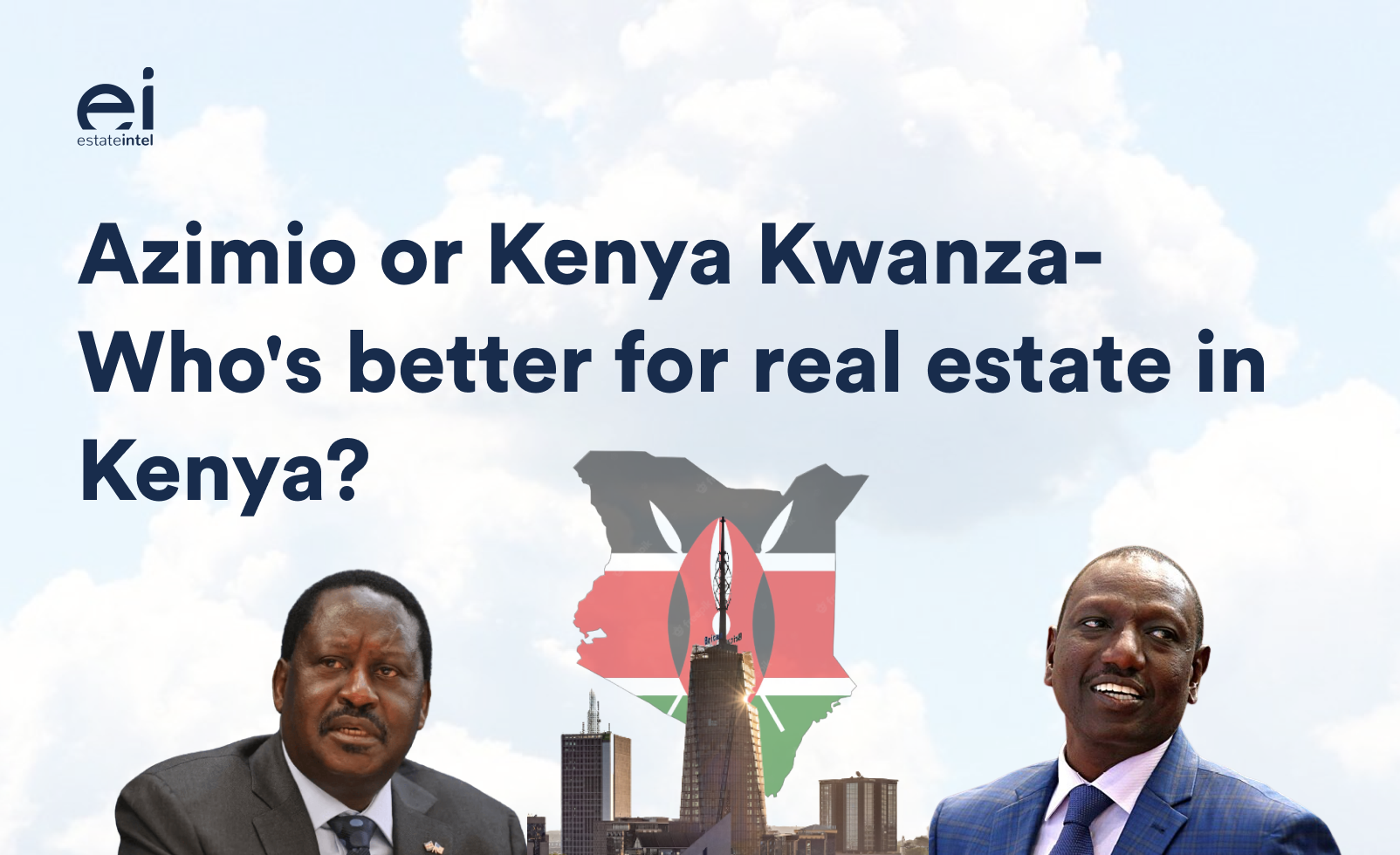Azimio or Kenya Kwanza- Who's better for real estate in Kenya
Tilda Mwai . 1 year ago

Share this post
Subscribe to our newsletter
Affordable housing has been one of Kenya’s government ‘Big 4’ agenda for the outgoing Jubilee government. With a pledge to construct 500,000 affordable homes between 2017 and 2022, the sector has seen investor interest ramp up over the past 5 years.This has included innovative approaches such as the £35 million (Ksh 5.2 billion) funding commitment…
Affordable housing has been one of Kenya’s government ‘Big 4’ agenda for the outgoing Jubilee government. With a pledge to construct 500,000 affordable homes between 2017 and 2022, the sector has seen investor interest ramp up over the past 5 years.This has included innovative approaches such as the £35 million (Ksh 5.2 billion) funding commitment to a Kenyan green affordable housing venture between UK Climate Investments (UKCI) and FSD Africa Investments (FSDAi) targeting the delivery of approximately 10,000 homes.
As such, a new government will either see momentum on affordable housing and general real estate retained or the sector moved to the back burner with other reform agendas prioritized. And with less than a month left till Kenya’s presidential elections, we embark on a fact presenting exercise to see which candidate may be better for Kenya’s real estate sector based on what was presented in their manifestos between the two front runners in the Azimio coalition under Raila Odinga’s candidacy and Kenya Kwanza Coalition under William Ruto’s candidacy.
Both Manifesto’s are laid out first, then commentary and analysis follows.
Azimio’s Government Real Estate Pledges
Azimio outlines construction and real estate as part of its economic growth plan. As such the Azimio government commits to;
- Promote and support local manufacture of machines, steel, aluminium and other products required by the construction industry in Kenya, Africa Free Continental Trade Areas (AfCFTA) and the rest of the world
- Review the policy and legislative framework of the industry with a view to improving sector coordination
- Encourage use of innovation in construction to reduce costs while ensuring high standards
- Support Kenyans in the diaspora to invest in the construction and real estate sector through a safe, digital portal.
- Fast track payment of existing pending bills and going forward strictly adhere to prompt payments as stated in law
- Fast-track dispute resolution between stakeholders and government
- Address impunity and corruption with a view to ensuring adherence to procurement procedures
- Replace the multi-layered taxation system with a unified, solitary tax economy.
- Encourage realty firms to shift from the percentage completion method to project completion method.
- Introduce consistency in rules and regulations across counties and foster consistent implementation
Further, the Azimio Manifesto outlines affordable Housing under its social transformation pillar and commits to expand access to affordable housing by;
- Supporting county governments to build new and decent social housing
- Investing in the construction of affordable homes and provision of social services
- Promoting access to appropriate, adequate and affordable low cost housing in urban areas by supporting local manufacturers of construction materials and using appropriate low-cost construction technology and modern innovative building technologies.
- Production of units at scale;
- Providing an enabling environment (facilitates innovation, embraces technology, and commercial arrangements) that can bring down the cost of construction.
- Building settlements that are close to economic centers of activities and facilitate shorter commutes to work;
- Providing access to amenities close to where people will live: schools, hospitals, playgrounds, markets, and transport corridors; as well as planned mobility infrastructure: facilitate movement of people while limiting environmental impacts.
- Subsidizing the land cost to qualifying partners and investors for development of affordable housing conditional on pricing at stated targets. In these areas, the Government will also provide adequate bulk infrastructure.
- Providing tax incentives focused on the cost of construction. This will include;
- 16% VAT on construction inputs: exemption for affordable housing development schemes. Translating to 9% reduction in construction costs;
- 15% corporate tax for developers with projects producing at least 100 affordable housing units;
- Reduction of import duties for AHP construction inputs 3
10. Recapitalising Kenya Mortgage Refinancing Company (KMRC) to continue working with the banks and other qualified financial institutions to specifically enhance affordability of mortgages by refinancing existing and future loan portfolios to the affordable housing segment and support secondary liquidity/ refinancing in the affordable mortgages segment.
11.Providing Incentives toward homeownership which include;
- Zero rating of stamp duty for first time home buyers
- iTax relief of up to KES 150,000 annually for savings in approved Homeowners Savings Plan, including withdrawals to pay for a home. Reduced tax liability while saving for a home
- Tax relief on interests paid on a mortgage up to a maximum of Kshs 300,000 p.a
- 15% tax relief on contributions to the National Housing Development Plan
- Continue with pensions policy: changes to the Retirement Benefits Act have now allowed pension contributors to access up to 40% of their savings for payments towards the purchase of a home.
12. Improve the living standards by supporting county governments to enhance social housing for the vulnerable identified as people living below USD 1.9 a day
13. Support Kenyans in the diaspora in owning homes
14 Financing affordable homes through:
- Establishing and structuring an appropriate Housing Fund for home purchase
- Providing affordable long term Tenant Purchase Schemes (TPS) to low-income earners through the Housing Fund
- Establish first home owners scheme for new job entrants and MSMEs startup owners
- Structure affordable long term credit for developers
Kenya Kwanza’s Government real estate pledges
Under their bottom up economic model, Kenya Kwanza identifies housing and settlement as part of the five sectors that form the core pillars of their manifesto. In cognition of the limited nature of resources, the plan adopts a value chain framework keen on exploring the value add ons by sectors such as finance and manufacturing into the challenge of affordable housing as part of its implementation framework.
In addition the plan further commits to;
- Increase supply of new housing to 250,000 p.a and percentage of affordable housing supply from 2% to 50%. This will be achieved by structuring affordable long term housing finance schemes including a National Housing Fund and Cooperative Social Housing Schemes that will guarantee offtake of houses from developers
- Grow number of mortgages from 30,000 to 1,000,000 by enabling low cost mortgages of Sh10,000 and below possible
- Strengthen Jua Kali industry capacity to produce high quality construction productions
- Giving developers incentives to build more affordable housing.
The plan also expands its core focus into the rural areas with a core commitment to establish a settlement fund with a budget estimate of KSH 250 billion sourced from the national government(KSH 50 bn) and pension funds(KSH 200 bn) to enable government resettlements.
Commentary
Both manifestos take different approaches to tackling the affordable housing challenge in the country.
Azimio’s manifesto focuses on creating an enabling environment with their commitments to tax subsidies, policy review, and innovation all aimed at enabling the construction of affordable housing.
Quite commendable, the plan also recognizes real estate as part of the sectors enabling economic growth. As such it outlines the opportunities to leverage on, including, the African continental free trade agreement as well as its commitments to the sector’s stakeholders by fast tracking policies and committing to a faster dispute resolution process, all of which are core enablers to real estate stakeholders.
While the plan provides detailed commitments on the exact issues to be addressed, its execution strategy is vague in most parts and does not address the ‘how’ on plans such as supporting the county governments to provide social housing, encouraging realty firms to move from percentage completion method to project completion method and supporting diaspora community in owning homes. This leaves these plans prone to the old age challenge of budget deficits and lack of adequate monetary investments for execution.
On the other hand, Kenya Kwanza’s approach is more direct with a pledge to leverage on national housing schemes to increase affordable housing from the current 2% of estimated demand to 50%. The plan even goes a step further to uniquely address rural housing and settlement, an often ignored niche area. The affordable mortgage scheme proposed by Kenya Kwanza is particularly commendable. Multiple benefits could stem from this for all the different real estate stakeholders.
However, the plan fails to address the existing challenges to its main agenda points. High cost of capital for example, has been the key driver to low mortgage take up. The agenda fails to outline exactly how it will tackle this challenge especially in relation to private lenders.
On direct provision of housing, the current government’s target for example, of constructing over 500,000 affordable housing in the 5 year period between 2017-2022, is currently lagging behind despite an influx in developer subsidies and government provision of land with research indicating that only 2613 units have been constructed so far since 2017 with an additional 3480 units under construction as at December 2021. As such, Kenya Kwanza’s pledge to increase housing to 250,000 per annum, while necessary, fails to outline any differential approach that will help it obtain its target.
We love your feedback! Let us know who you think will be better for the real estate sector in Kenya based on the facts above by sending an email to [email protected].
Related News
You will find these interesting

Bisi Adedun . October 2023
Jabi is an area located within the phase 2 vicinity of the Abuja Municipality, known for housing the iconic Jabi Lake. I...
abuja
Jabi Lake

Tilda Mwai . August 2023
africa
Africa real estate outlook

Deborah Jesusegun . June 2023
African
building